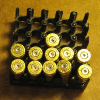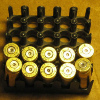I got a great deal on a bunch of 220 grain, plated, 10mm/.40 S&W diameter (.400") bullets, but now I'm thinking I got screwed, because I can't find load data ANYWHERE.
No published source lists anything heavier than 205 grains. I am not too excited about going with the recipe Bubba "heard about" at a gun show.
I guess I could work up from the 205 gr. load data (Lee reloading manual, actually for a cast bullet, but cast data is usually safe to use w/plated). But I'd still be exploring unknown territory.
***? Did I just buy myself a lot of small, shiny paperweights?
No published source lists anything heavier than 205 grains. I am not too excited about going with the recipe Bubba "heard about" at a gun show.
I guess I could work up from the 205 gr. load data (Lee reloading manual, actually for a cast bullet, but cast data is usually safe to use w/plated). But I'd still be exploring unknown territory.
***? Did I just buy myself a lot of small, shiny paperweights?







